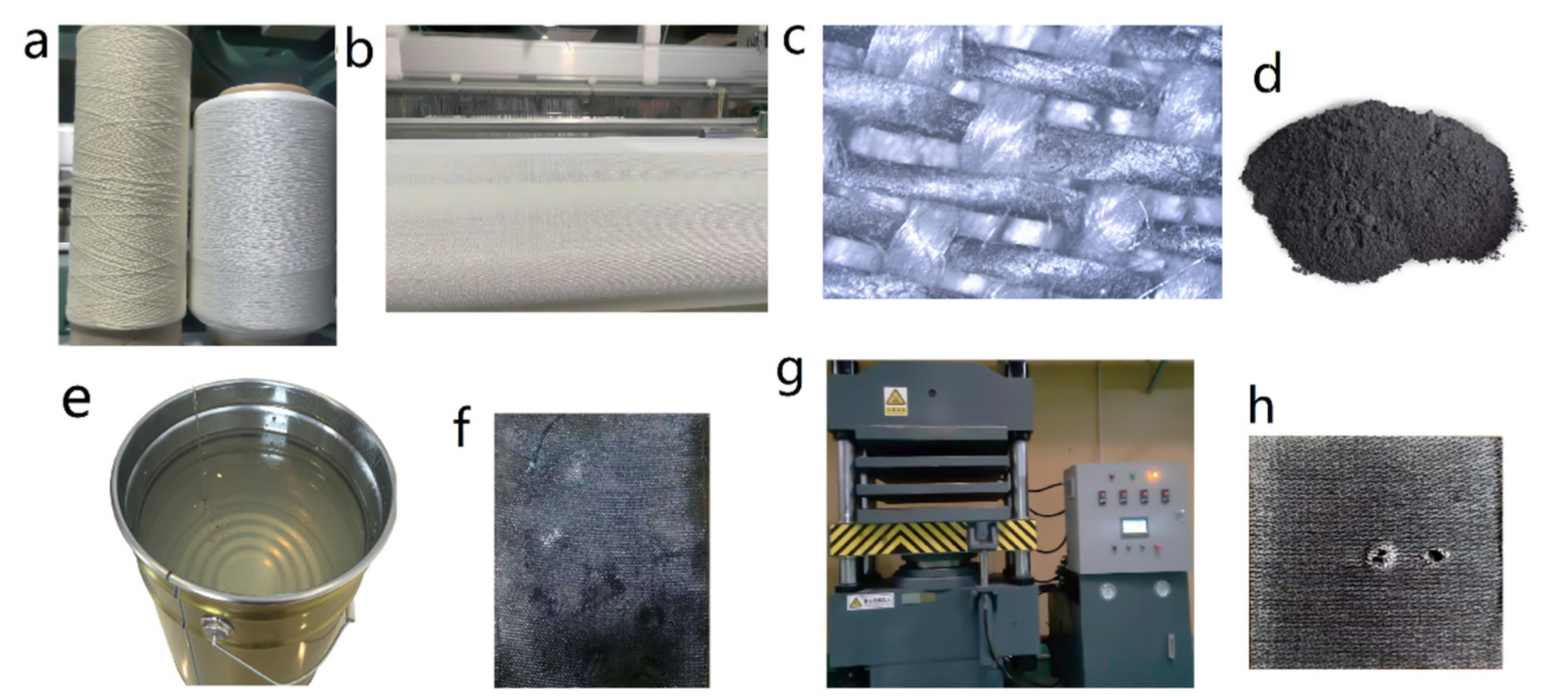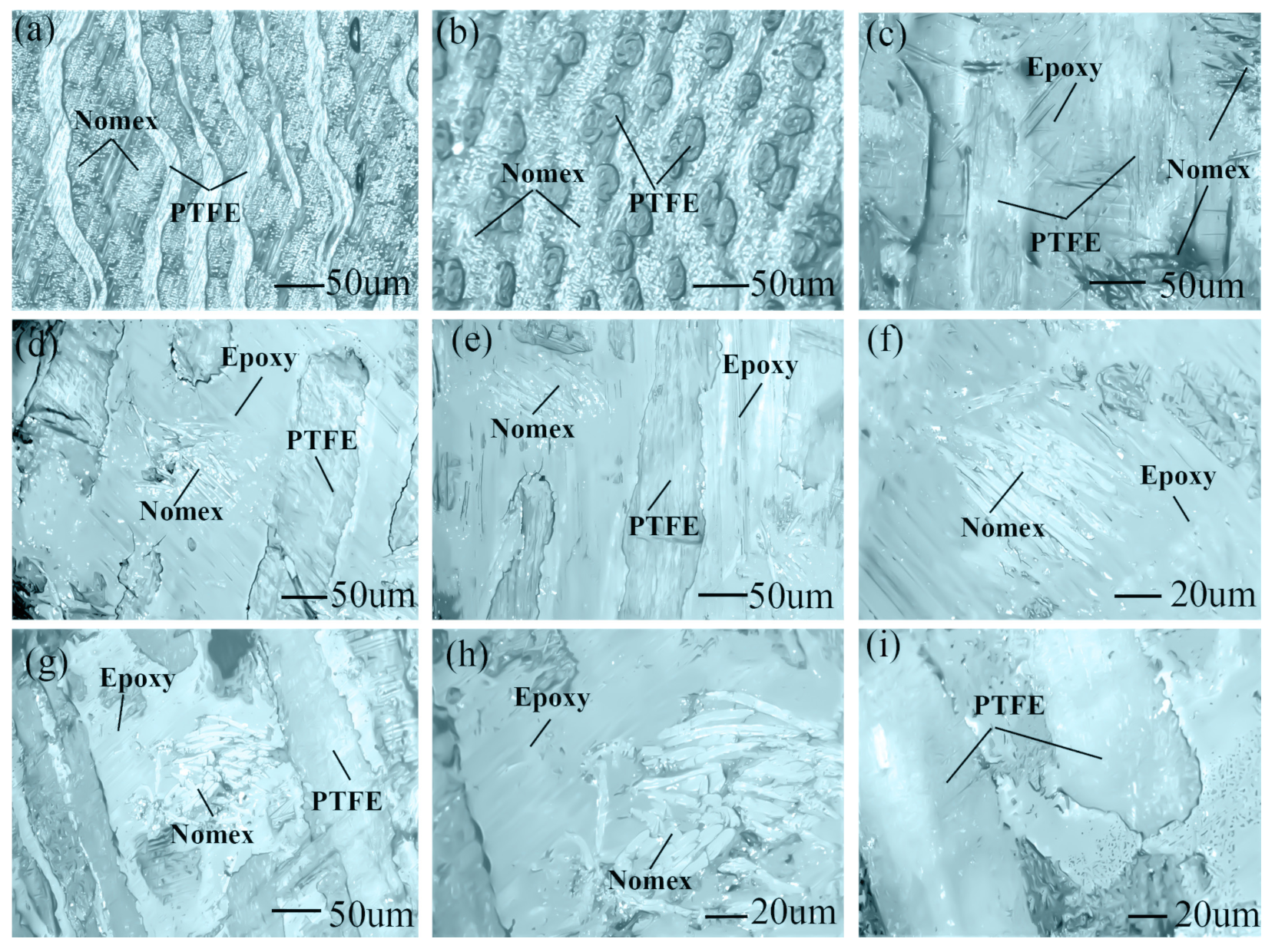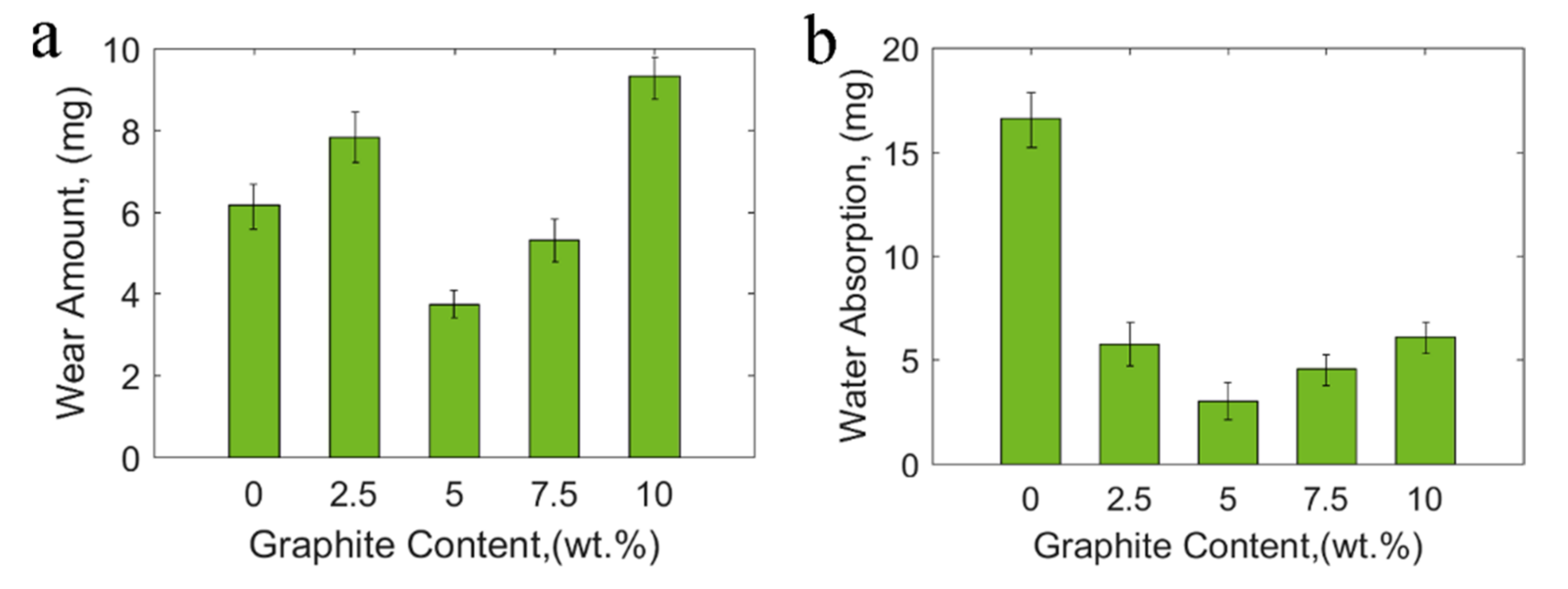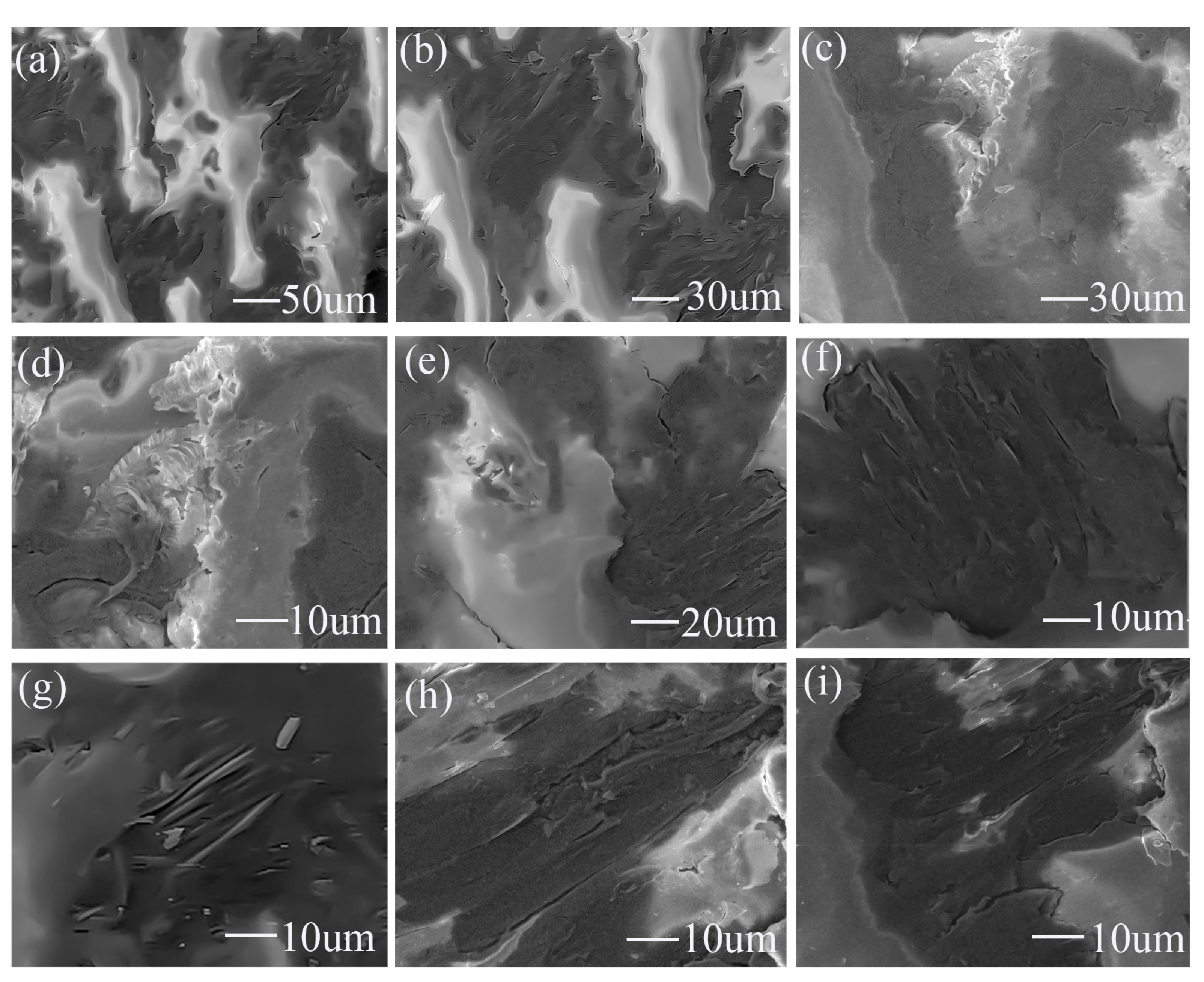Enhancement of the Water-Lubricated Tribological Properties of Hybrid PTFE/Nomex Fabric Laminate Composite via Epoxy Resin and Graphite Filler
Abstract
:1. Introduction
2. Experiment
2.1. Equipment and Sample Preparation
2.2. Friction and Wear Test
3. Results and Discussion
3.1. The Results of Friction Coefficient (COF)
3.2. The Effect of Epoxy Resin and Hybrid Fabric
3.3. The Effect of Graphite Fillers
3.4. Laster Microscope Observations of Working Surface
3.5. SEM Images of the Worn Area under Water Lubrication after Soaking
4. Conclusions
- (1)
- The fabric sample has a lower underwater average COF and high underwater wear resistance. Underwater tribological properties were improved by the epoxy resin and graphite filler. The high strength and excellent adhesion of epoxy resin improved in water-wear resistance. The graphite filler and PTFE fibers reduced underwater COF.
- (2)
- The high strength of epoxy resin provides good support for hybrid fabrics. The underwater interlayers bonding force remains strong after soaking. The surface of Nomex fibers was flatter and smoother without noticeable peeling and was still firmly bound in the epoxy resin after wear.
- (3)
- Graphite filler acts as a solid lubricant for improving wear resistance and reducing COF via a good load carrying capacity and participating in the formation of transfer film on the metal pin. Adhesive wear and rolling deformation of PTFE fibers occurred, both of which were conducive to the formation of transfer film on the metal pin.
Author Contributions
Funding
Institutional Review Board Statement
Informed Consent Statement
Conflicts of Interest
References
- Yang, M.; Zhang, Z.; Yuan, J.; Wu, L.; Zhao, X.; Guo, F.; Liu, W. Fabrication of PTFE/Nomex fabric/phenolic composites using a layer-by-layer self-assembly method for tribology field application. Friction 2020, 8, 335–342. [Google Scholar] [CrossRef] [Green Version]
- Yu, M.; Wang, S.; Ren, F.; Wu, Y.; Ren, M.; Li, Y.; Ma, P. The friction and wear behaviors of self-lubricating composites with two types of warp-knitted fabric structures. J. Ind. Text. 2020, 1–19. [Google Scholar] [CrossRef]
- Ren, G.; Zhang, Z.; Zhu, X.; Men, X.; Liu, W. Influence of lubricant filling on the dry sliding wear behaviors of hybrid PTFE/Nomex fabric composite. J. Mater. Sci. 2014, 49, 3716–3724. [Google Scholar] [CrossRef]
- Yang, M.; Yuan, J.; Guo, F.; Wang, K.; Zhang, Z.; Men, X.; Liu, W. A biomimetic approach to improving tribological properties of hybrid PTFE/Nomex fabric/phenolic composites. Eur. Polym. J. 2016, 78, 163–172. [Google Scholar] [CrossRef]
- Wei, F.; Pan, B.; Lopez, J. The tribological properties study of carbon fabric/epoxy composites reinforced by nano-TiO2 and MWNTs. Open Phys. 2018, 16, 1127–1138. [Google Scholar] [CrossRef]
- Rajaei, M.; Wang, D.; Bhattacharyya, D. Combined effects of ammonium polyphosphate and talc on the fire and mechanical properties of epoxy/glass fabric composites. Comp. Part B Eng. 2017, 113, 381–390. [Google Scholar] [CrossRef]
- Ibrahim, M.B.; Habib, H.Y.; Jabrah, R.M. Preparation of kevlar-49 fabric/e-glass fabric/epoxy composite materials and characterization of their mechanical properties. Rev. Des Compos. Et Des Mater. Av.-J. Compos. Adv. Mater. 2020, 30, 133–141. [Google Scholar] [CrossRef]
- Jiang, S.; Li, J.; Liu, S.; Zhou, N.; Yu, A.; Deng, Y. Tribological properties of hybrid surface textured GCr15 steel filled by epoxy resin-based material under dry friction. Surf. Topogr. Metrol. Prop. 2019, 7, 0250182. [Google Scholar] [CrossRef]
- Zahabi, S.R.; Sheikhzadeh, M.; Akbarzadeh, S.; Abuzade, R.; Ko, F. Hybrid PTFE-glass hierarchical braided/epoxy composites with self-lubricating and high tribological performance. J. Ind. Text. 2020, 1528083720977210. [Google Scholar] [CrossRef]
- Larsen, T.O.; Andersen, T.L.; Thorning, B.; Horsewell, A.; Vigild, M.E. Changes in the tribological behavior of an epoxy resin by incorporating CuO nanoparticles and PTFE microparticles. Wear 2008, 265, 203–213. [Google Scholar] [CrossRef]
- Yang, M.; Zhu, X.; Ren, G.; Men, X.; Guo, F.; Li, P.; Zhang, Z. Influence of air-plasma treatment and hexagonal boron nitride as filler on the high temperature tribological behaviors of hybrid PTFE/Nomex fabric/phenolic composite. Eur. Polym. J. 2015, 67, 143–151. [Google Scholar] [CrossRef]
- Yang, M.; Zhang, Z.; Yuan, J.; Wu, L.; Li, P.; Zhao, X.; Men, X. Enhanced mechanical and tribological properties of Kevlar/PTFE-phenolic composites by improving interfacial properties by aramid nanofibers. Polym. Comp. 2019, 41, 4192–4201. [Google Scholar] [CrossRef]
- Zhao, B.; Bai, T. Improving the tribological performance of epoxy coatings by the synergistic effect between dehydrated ethylenediamine modified graphene and polytetrafluoroethylene. Carbon 2019, 144, 481–491. [Google Scholar] [CrossRef]
- Yu, Z.J.; Kang, E.T.; Neoh, K.G.; Tan, K.L. Surface passivation of epoxy resin with a covalently adhered poly(tetrafluoroethylene) layer. Surf. Coat. Technol. 2001, 138, 48–55. [Google Scholar] [CrossRef]
- Su, F.H.; Zhang, Z.Z.; Wang, K.; Jiang, W.; Liu, W.M. Tribological and mechanical properties of the composites made of carbon fabrics modified with various methods. Comp. Part A Appl. Sci. Manuf. 2005, 36, 1601–1607. [Google Scholar] [CrossRef]
- Yang, M.; Yuan, J.; Men, X.; Zhang, Z.; Guo, F.; Liu, W. Effect of ZrB2 particles incorporation on high-temperature tribological properties of hybrid PTFE/Nomex fabric/phenolic composite. Tribol. Int. 2016, 99, 289–295. [Google Scholar] [CrossRef]
- Zhang, H.; Zhang, Z.; Guo, F. A study on the sliding wear of Hybrid PTFE/kevlar fabric/phenolic composites filled with nanoparticles of TiO2 and SiO2. Tribol. Trans. 2010, 53, 678–683. [Google Scholar] [CrossRef]
- Su, F.H.; Zhang, Z.Z. Friction and wear of Synfluo 180XF wax and nano-SiO2 filled hybrid glass/PTFE fabric composites with phenolic resin binder. Plast. Rubber and Comp. 2010, 39, 350–356. [Google Scholar] [CrossRef]
- Yang, M.; Zhang, Z.; Yuan, J.; Guo, F.; Men, X.; Liu, W. Growth of Mo2C nanoparticles on graphene as lubricant filler for high tribological performances of fabric self-lubricating liner composites. RSC Adv. 2016, 6, 110070–110076. [Google Scholar] [CrossRef]
- Zhang, H.; Zhang, Z.; Guo, F.; Jiang, W. Surface modification of CuS nanoparticles and their effect on the tribological properties of hybrid PTFE/kevlar fabric/phenolic composite. J. Comp. Mater. 2010, 44, 2461–2472. [Google Scholar] [CrossRef]
- Yang, M.; Zhang, Z.; Zhu, X.; Men, X.; Ren, G.; Liu, W. Tribological Behaviors of Molybdic Acid-Modified Phenolic/Polyfluo Wax Composite Coating. Tribol. Trans. 2016, 59, 428–434. [Google Scholar] [CrossRef]
- Xia, H.; Li, J.; Wang, K.; Hou, X.; Yang, T.; Hu, J.; Shi, Z. Superior wear resistance of epoxy composite with highly dispersed graphene spheres. Adv. Comp. Hybrid Mater. 2021, 1–11. [Google Scholar] [CrossRef]
- Zhang, Z.; Du, Y.; Zhu, C.; Guo, L.; Lu, Y.; Yu, J.; Guo, D. Unprecedented enhancement of wear resistance for epoxy-resin graphene composites. Nanoscale 2021, 13, 2855–2867. [Google Scholar] [CrossRef]
- Zhang, H.; Zhang, Z.; Guo, F. Studies of the influence of graphite and MoS2 on the tribological behaviors of hybrid PTFE/nomex fabric composite. Tribol. Trans. 2011, 54, 417–423. [Google Scholar] [CrossRef]
- Ren, F.; Wang, S.; Yu, M.; Duan, H.; Su, M.; Ren, M.; Sun, J. Influence of graphite/graphene on the tribological behaviors of self-lubricating fabric composite. Materials 2020, 13, 232. [Google Scholar] [CrossRef] [Green Version]
- Wang, Z.; Gao, D. Tribological behavior of plastic composites and stainless steel in seawater. Emerg. Mater. Res. 2017, 6, 108–116. [Google Scholar] [CrossRef]
- Ren, G.; Zhang, Z.; Zhu, X.; Men, X.; Jiang, W.; Liu, W. Tribological behaviors of hybrid PTFE/nomex fabric/phenolic composite under dry and water-bathed sliding conditions. Tribol. Trans. 2014, 57, 1116–1121. [Google Scholar] [CrossRef]
- Meng, H.; Sui, G.X.; Xie, G.Y.; Yang, R. Friction and wear behavior of carbon nanotubes reinforced polyamide 6 composites under dry sliding and water lubricated condition. Comp. Sci. Technol. 2009, 69, 606–611. [Google Scholar] [CrossRef]
- Chen, B.; Yang, J.; Wang, J.; Liu, N.; Yan, F. Comparative investigation on the friction and wear behaviors of carbon fabric-reinforced phenolic composites under seawater lubrication. Tribol. Trans. 2015, 58, 140–147. [Google Scholar] [CrossRef]
- Hu, D.; Guo, Z.; Jun, T.; Yuan, C. A Novel Hydrophilic PVA fiber reinforced thermoplastic polyurethane materials for water-lubricated stern bearing. Fibers Polym. 2021, 22, 171–183. [Google Scholar] [CrossRef]
- Liu, N.; Wang, J.; Yang, J.; Han, G.; Yan, F. Enhancement on interlaminar shear strength and water-lubricated tribological performance of high-strength glass fabric/phenolic laminate by the incorporation of carbon nanotubes. Polym. Adv. Technol. 2014, 25, 1572–1579. [Google Scholar] [CrossRef]
- Zhang, Z.; Guo, F.; Wang, K.; Jiang, W. Enhanced wear resistance of hybrid PTFE/Kevlar fabric/phenolic composite by cryogenic treatment. J. Mater. Sci. 2009, 44, 6199–6205. [Google Scholar] [CrossRef]
- Kumar, S.; Singh, K.K.; Ramkumar, J. Comparative study of the influence of graphene nanoplatelets filler on the mechanical and tribological behavior of glass fabric-reinforced epoxy composites. Polym. Comp. 2020, 41, 5403–5417. [Google Scholar] [CrossRef]
- Cao, F.; Jiang, P.; Yan, F. Surface functionalizing effect of fillers on the tribological properties of MWCNT reinforcement HSGFs/phenolic laminate composites under water lubrication. Polym. Adv. Technol. 2018, 29, 767–774. [Google Scholar] [CrossRef]
- Liu, N.; Wang, J.; Chen, B.; Han, G.; Yan, F. Enhancement on interlaminar shear strength and tribological properties in water of ultrahigh molecular weight polyethylene/glass fabric/phenolic laminate composite by surface modification of fillers. Mater. Des. 2014, 55, 805–811. [Google Scholar] [CrossRef]









Publisher’s Note: MDPI stays neutral with regard to jurisdictional claims in published maps and institutional affiliations. |
© 2021 by the authors. Licensee MDPI, Basel, Switzerland. This article is an open access article distributed under the terms and conditions of the Creative Commons Attribution (CC BY) license (https://creativecommons.org/licenses/by/4.0/).
Share and Cite
Liu, Y.; Gao, G.; Jiang, D.; Yin, Z. Enhancement of the Water-Lubricated Tribological Properties of Hybrid PTFE/Nomex Fabric Laminate Composite via Epoxy Resin and Graphite Filler. Materials 2022, 15, 62. https://doi.org/10.3390/ma15010062
Liu Y, Gao G, Jiang D, Yin Z. Enhancement of the Water-Lubricated Tribological Properties of Hybrid PTFE/Nomex Fabric Laminate Composite via Epoxy Resin and Graphite Filler. Materials. 2022; 15(1):62. https://doi.org/10.3390/ma15010062
Chicago/Turabian StyleLiu, Ying, Gengyuan Gao, Dan Jiang, and Zhongwei Yin. 2022. "Enhancement of the Water-Lubricated Tribological Properties of Hybrid PTFE/Nomex Fabric Laminate Composite via Epoxy Resin and Graphite Filler" Materials 15, no. 1: 62. https://doi.org/10.3390/ma15010062





